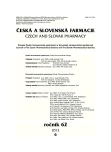Alkalimetric titrations of salts of organic bases in the Pharmacopoeia
Authors:
Želmíra Bezáková; Mária Stankovičová
Authors‘ workplace:
Bratislava, Slovenská republika
; Katedra farmaceutickej chémie FaF UK
Published in:
Čes. slov. Farm., 2013; 62, 264-269
Category:
Original Articles
Overview
Modified methods – alkalimetry in ethanol 70% with a defined small volume of hydrochloric acid 0.01 mol/l added to the solution of the sample before the titration and alkalimetry in ethanol 70% or ethanol 96% alone with potentiometric end-point detection for the assay of halide salts of 11 organic N-bases has been investigated. The results were compared to those obtained by the method of the European Pharmacopoeia 7th Ed. (Ph. Eur. 7th Ed.). The Ph. Eur. 7th Ed. use for 8 investigated substances alkalimetry in alcohol 96 % with a defined small volume of hydrochloric acid 0.01 mol/l (5 ml) with potentiometric end-point detection: Cinchocaine hydrochloride, Codeine hydrochloride dihydrate, Ethylmorphine hydrochloride, Lidocaine hydrochloride, Papaverine hydrochloride, Pilocarpine hydrochloride, Quinine hydrochloride, Tetracaine hydrochloride. Our results revealed that the Ph. Eur. 7th Ed. method did not work for 5 drugs from this group: Cinchocaine hydrochloride, Ethylmorphine hydrochloride, Papaverine hydrochloride, Pilocarpine hydrochloride and Tetracaine hydrochloride. In the group of investigated substances we included also drugs with the character of weak organic bases for which Ph. Eur. 7th Ed. prescribed different methods for their assay: Thiamine hydrochloride and Pyridoxine hydrochloride – acidimetric titration in non-aqueous solvents with perchloric acid and Procaine hydrochloride – determination of primary aromatic amino-nitrogen (Ph. Eur. 7th Ed., chapter 2.5.8).
Keywords:
weak organic bases • alkalimetry • potentiometric end-point detection • assay
Sources
1. European Pharmacopoeia, 7th Ed. Strasbourg: Cedex, Council of Europe 2010.
2. Gyenes I. Titrationen in nichtwässrigen Medien, 3. Aufl., Stuttgart: F. Enke Verlag 1970; 701.
3. Šafařík L., Kašová M. Die nichtwässrige Protometrie als Arzneibuchmethode zur Gehaltsbestimmung von Arzneistoffen. Pharmazie 1984; 39, 843.
4. Fritz J. S. Acid-base Titration in Nonaqueous Solutions Boston: Allyn and Bacon Inc. 1973; 142.
5. Šafařík L., Stránský Z. Odměrná analýza v organických rozpouštědlech. Praha: SNTL 1982; 399 s.
6. Bezáková Ž., Bachratá M., Blešová M., Šubert J. Acidobázické titrácie v nevodnom prostredí vo farmaceutickej analytike II. Acidimetria 1. Českoslov. Farm. 1993; 42, 7–27.
7. Bezáková Ž., Šubert J. Acidobázické titrácie v nevodnom prostredí vo farmaceutickej analytike II. Acidimetria 2. Čes. a slov. Farm. 1994; 43, 43–63.
8. European Pharmacopoeia, 3rd Ed. Strasbourg: Cedex, Council of Europe 1997.
9. European Pharmacopoeia, 4th Ed. Strasbourg: Cedex, Council of Europe 2002.
10. Deutsches Arzneibuch, 7th Ed. Stuttgart: Deutscher Apotheker-Verlag 1968.
11. Bye R. Theoretical and practical considerations of the newer methods of the European Pharmacopoeia for the assay of halide salts of organic bases. Sci. Pharm. 2002; 70, 129.
12. Pohl B. Pyridoxin-HCl. In: Bracher F., Heisig P., Langguth P., Mutschler E., Rücker G., Scriba G., Stahl-Biskup E (ed.) Kommentar zum Europäischen Arzneibuch. Stuttgart: Wissenschaftliche Verlagsgesellschaft 2002.
13. Kos N., Surmann J. P. Die Gehaltsbestimmung von Pyridoxinhydrochlorid (Vitamin B6) nach Ph. Eur. 4. Ausgabe, Grundwerk 2002. Pharmazie 2006; 61, 414–416.
14. Connors K. A. A textbook of Pharmaceutical Analysis. J. Wiley & Sons, 1967; 614.
15. Newton D. W., Kluza Ronald B. pKa value of medicinal compounds in pharmacy practice. Drug Intelligence and Clinical Pharmacy 1978; 12, 546–554.
16. Takács-Novák K., Völgyi G. Alkalimetry in alkohol-water mixtures with potentiometric end-point detection. Critical remarks on a newer method of European Pharmacopoeia. Anal. Chim. Acta. 2004; 507, 275–280.
17. Československý lékopis, 4. vyd., 2. Svazek. Praha: Avicenum-Zdravotnické nakladatelství, n.p. 1987, 697–698.
18. European Pharmacopoeia, 4th Ed., Supplement 4.2. Strasbourg: Cedex, Council of Europe 2002.
19. European Pharmacopoeia, 4th Ed., Supplement 4.3. Strasbourg: Cedex, Council of Europe 2002.
Labels
Pharmacy Clinical pharmacologyArticle was published in
Czech and Slovak Pharmacy

2013 Issue 6
Most read in this issue
- A view on providing care in the field of medicines in Slovakia – the pharmacist and the patient
- Alkalimetric titrations of salts of organic bases in the Pharmacopoeia
- Influence of quaternary ammonium salt on liberation of drug with antiseptic effect
- Physiological factors with impact on the drug behaviour in the gastrointestinal tract
